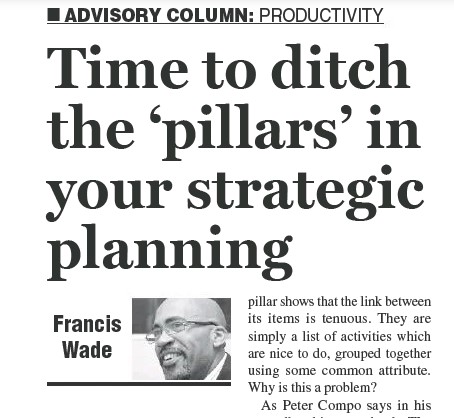You finally have time to look back at outputs from prior strategic planning retreats. A quick glance reveals an approach they used which includes “pillars”. If so, be aware: there are some drawbacks to this technique that could lead to a weak plan.
But you must make a decision about what to use going forward. You need to craft an approach, but why should you be wary? To understand why, let’s go back to the process typically followed.
It usually begins with a review of the company’s vision and mission statements. Then, a SWOT and PESTEL analysis of the environment are also done. Next, the team brainstorms projects which are necessary for the organization to achieve the vision. Finally, these projects are grouped into three to five pillars based on common themes.
The final product is often diagrammed as a building with the vision and mission statements in the roof, supported by the pillars. However, its simplicity belies the fact that there are some good reasons to use a different approach.
- Pillars are merely semi-random lists
A review of the contents of each pillar shows that the link between its items is tenuous. They are simply a list of activities which are nice to do, grouped together using some common attribute. Why is this a problem?
As Peter Compo says in his groundbreaking new book, “The Emergent Approach to Strategy”, anything that resembles a to-do list is not a strategic plan.
Instead, he reasons that, at the heart of an overall framework, should be a triad: an aspiration, a bottleneck and a strategy. What is the role of each element?
- The aspiration defines the overall goal or outcome desired.
- The bottleneck represents the primary obstacle which stands in the way of achieving your accomplishment.
- The strategy defines the way in which the bottleneck will be “beaten” or loosened so that the aspiration is easy to achieve.
Together, these three elements form a hypothesis. It represents the most important changes the organization needs to make. Plus, it evolves as further information and experiences are gathered.
Unfortunately, the pillars approach masks this important nuance. Instead, it assumes that all you need to do is mobilize staff to execute disconnected projects. If this were so, executing strategic plans would be easy.
Instead, in the real world, planning teams need to adjust their hypotheses on the fly as technology advances, government regulations change, competitors take action, and customer tastes change. Together, these shifts force changes in the original hypothesis, a fact of life the pillars approach ignores.
- Pillars hide relationships
Pillars also over-simplify reality. A mere list of activities hides the fact that projects are always interconnected. But more importantly, they only produce outcomes after the correct chain of causal relationships is followed.
For example, if you are a retailer, you may believe that an Easter Sale will bring in added revenue. However, to achieve the final result, a number of other actions need to take place.
You must become effective at reaching your audience with a promotion. Also, the sale should be launched on the right day of the month to hit paydays. Finally, the season has to be ideal for shopping, as some folks restrain their “retail therapy” during Lent.
The point is that the strategy relies on a number of variables which need to work together, but are imperfectly understood. As such, success is far from assured. The pillar approach obscures this reality and over-simplifies the challenge.
The truth is that strategy is an art in which your actions (causes) are separated from the results (the effects) in time and space. Sometimes the gap can be decades long, or thousands of miles apart.
Fortunately, there are better tools to use, like strategy maps, invented by Drs. Kaplan and Norton. These diagrams preserve the connection between key activities. Furthermore, they are easy to understand and explain to other employees.
3. Pillars emphasize short-term thinking
None of the pillar-approach strategic plans I have seen take into account long-term strategies and results. Instead, they tend to be so simple that they only work for plans which are five years or less in duration.
As such, the lists of projects in each pillar don’t tell a long-term narrative or story which builds a timeline.
Without it, complex undertakings lasting several decades aren’t possible. Think of the planning it takes to build a cathedral over a span of more than 200 years, for example.
Consequently, the list of projects found in a pillar only works for short-term tactical assignments in which the sequence doesn’t matter. This is a major drawback. The technique can’t be used to produce an inspiring, monumental accomplishment.
To craft an alternate approach, read my Gleaner article from March 19th 2023, as an example.
Francis Wade is the author of Perfect Time-Based Productivity, a keynote speaker and a management consultant. To search his prior columns on productivity, strategy, engagement and business processes, send email to columns@fwconsulting.com.

